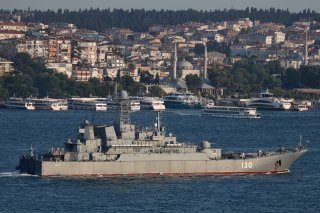The Russian Navy Is Flexing Its Muscles in the Mediterranean Sea
Russia is expanding its naval presence in the Eastern Mediterranean because it’s easier than trying to compete with the United States on the world’s oceans.
Here's What You Need to Remember: Russia faces severe challenges in maintaining a meaningful naval presence in the Mediterranean, Gorenburg points out. Russia’s economy is sputtering, the country’s shipyards have been plagued by delays, and supplying its Mediterranean forces through the Bosporus chokepoint in wartime could be a problem.
Is the Mediterranean the new playground for the Russian Navy?
Russia is expanding its naval presence in the Eastern Mediterranean because it’s easier than trying to compete with the United States on the world’s oceans, according to Dmitry Gorenburg, an expert on the Russian military, in an analysis for the George C. Marshall European Center for Security Studies.
“Maintaining naval presence in the Mediterranean is a far more effective strategy for the Russian Navy than pursuing a globally active blue-water navy because Russia has neither the resources nor the global ambitions to challenge U.S. naval supremacy around the world,” writes Gorenburg. “Moscow’s focus on developing and augmenting the Mediterranean squadron is thus a far more achievable limited objective that is well-aligned with Russia’s foreign policy objectives in the region.”
During the Cold War, Soviet warships were a familiar sight in the Mediterranean. The Fifth Eskadra, the Soviet Mediterranean squadron established in 1967, would tail U.S. aircraft carriers, ready to strike them with missiles, torpedoes and even nuclear weapons in the event of war. But with the collapse of the Soviet Union, the squadron was disbanded in 1992.
It was resurrected in 2013 as the Mediterranean Squadron, drawn primarily from the ships of the Black Sea Fleet, which itself has been equipped with several new submarines and surface ships. Meanwhile, the Syrian port of Tartus – a Cold War pit stop for the Fifth Eskadra – has again become a Russian base for servicing warships, including nuclear-powered vessels.
“Since the addition of six Varshavyanka-class submarines to the BSF in 2017, Russia has stationed two such vessels in Tartus, Syria,” Gorenburg writes. “Surface ships and submarines from Russia’s other fleets, mainly the Northern and Baltic, have participated in squadron operations at various times as well. The force has actively contributed to Russia’s military operations in Syria. In addition to delivering troops, BSF [Black Sea Fleet] vessels have fired Kalibr missiles at ground targets throughout Syria. Russian ships have also shadowed U.S. ships in the eastern Mediterranean, and Russian submarines deployed to the Mediterranean have tracked U.S. and NATO platforms there as well. The squadron has also facilitated Russian naval diplomacy efforts, as ships from the squadron have called at ports at Cyprus, Egypt, and Malta.”
In addition, Russian aircraft operate from Syrian bases, as well as a variety of missile systems, including S-400 and S-300 long-range and Pantsir short-range anti-aircraft missiles, as well as K-300 Bastian and Kh-35 coastal defense anti-ship missiles. A permanent force in the Mediterranean enhances Russian prestige in the region, deters Western military operations in the areas, and provides security against the Mediterranean as a base for hostile forces to strike the Russian homeland.
Gorenburg sees Moscow as eschewing an American-style power projection navy with its big aircraft carriers, in favor of a more defensive forces armed with access denial weapons such as small missile-equipped corvettes. “The idea is that the Russian Navy can use these ships to create maritime zones that are difficult for enemy forces to penetrate. These ‘A2/AD bubbles’ in the Black Sea and eastern Mediterranean form a set of layered defenses and multiple vectors of attack through the combination of long-range sea-, air-, and ground-launched missiles used to deny access, with shorter-range coastal and air defense systems focused on area denial.”
The old Soviet-era cruisers and destroyers will continue to make port visits for prestige, but the small ships and the missiles will form the essence of the Russian Navy in the Mediterranean and elsewhere. Gorenburg expects the Mediterranean Squadron will comprise 10 to 15 surface warships and a couple of submarines.
However, Russia faces severe challenges in maintaining a meaningful naval presence in the Mediterranean, Gorenburg points out. Russia’s economy is sputtering, the country’s shipyards have been plagued by delays, and supplying its Mediterranean forces through the Bosporus chokepoint in wartime could be a problem.
“Because of these challenges, Russian leadership would, prior to any outbreak in the eastern Mediterranean, have to choose whether to fight in the Mediterranean or attempt to bring forces back to the Black Sea to defend Russia’s southern borders. Should Russian forces stay in the Mediterranean, they would pose a serious threat to U.S. and NATO forces by creating an increasingly dense missile and electronic-warfare environment farther into the eastern Mediterranean Sea. Russia would have to expect that it would lose these forces to an ultimately numerically and qualitatively superior enemy force, albeit after exacting a potentially high cost on its adversary.”
Michael Peck is a contributing writer for the National Interest. He can be found on Twitter and Facebook.
This article first appeared in 2019.
Image: Reuters

